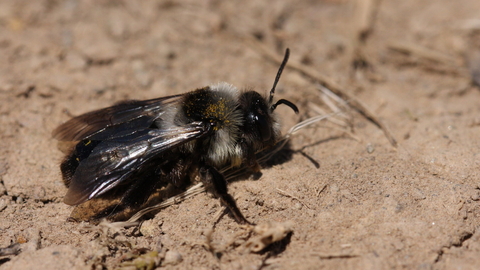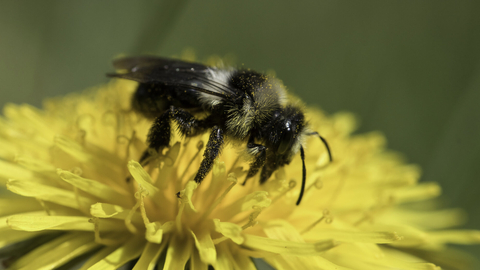
Ashy mining bee © Vaughn Matthews

Ashy mining bee © Chris Lawrence
Ashy mining bee
Scientific name: Andrena cineraria
This black and grey solitary bee takes to the wing in spring, when it can be seen buzzing around burrows in open ground.
Species information
Category
Statistics
Length: up to 1.5cmConservation status
Common
When to see
March to JulyAbout
The ashy mining bee is a solitary bee, which means that female bees live alone, each creating their own nest. Ashy mining bees usually emerge in March and can be seen until June, though are occasionally seen later in the year. They can be found in a wide range of open, sunny places, from coastal grassland, moorlands and riverbanks to quarries, parks and gardens. They collect nectar and pollen from spring flowering trees and shrubs like willow and blackthorn, as well as flowers such as dandelions and buttercups.Each female digs a nesting burrow in a patch of bare or almost bare earth, such as on a well-trodden footpath, a patchy lawn, or a heavily-grazed field. Their burrows are around 10-20cm deep. Sometimes many females will nest close together. Look out for a little heap of soil piled around the burrow entrance, like a miniature volcano. Once a female has dug a nest chamber, she adds some pollen to it, often moistened with nectar, and lays an egg next to it. She then seals off this chamber and moves on to the next. When each egg hatches, the larva will fatten up on the pollen and nectar, ready to pupate and emerge as an adult the following spring.
Like many solitary bees, ashy mining bees are targeted by a variety of parasites that try to lay their eggs in the bee's burrow. They are the main host of Lathbury's nomad bee, which sneaks into an unsealed nest chamber and lays its egg in the wall - the nomad bee larva hatches and kills the host's egg or larva, then feeds on the food left for it. They are also targeted by bee-flies, which hover near the burrow entrance and flick their eggs into the nest.
How to identify
The ashy mining bee is a similar size to a honey bee, with striking black and ash-grey or whitish hairs. Females have a glossy black abdomen (the rear part of the body), with a broad band of light grey hairs at each end of the thorax (the central part of the body, behind the head). They also have a patch of light grey or white hairs on the front of the face.Males are smaller than females, with similar markings, though the bands of hair are less distinct, with whitish hairs also spread along the sides of the thorax.
